
This page last modified: 25 June 2015 (link to Ingo Maier's Cambridge appendix added)

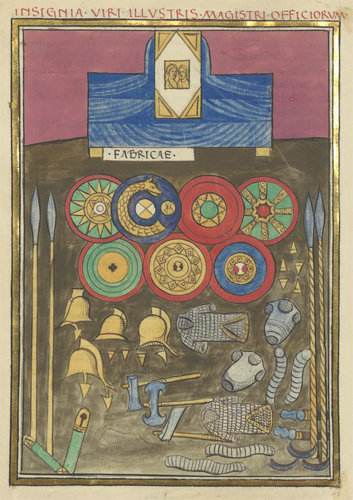 Above: Frontpiece from the Parisian manuscript (P). Note that P consistently spells scholae as scolae. |
The following units of military Scholae are listed as being under the command of the Master of Offices in the West (the numbers beside the names refer to Ingo Maier's numbering scheme):
107.2 Schola scutariorum primaThe shields are numbered as follows: Top row of four, left to right: 106#4, 106#5, 106#6, 106#7. Bottom row of three, left to right: 106#8, 106#9, 106#10. |
 Above: Frontpiece from the Bodleian manuscript (O). The similarity to that of P is evident. |
It can readily be seen that, unlike the illustrations that accompany the lists of units under normal field commanders, the shield patterns as shown above in both the P and O manuscripts are not labelled with specific unit names. Indeed, it is not certain that these shield patterns are even intended to represent the units under the command of the Master of Offices in the West, since he also has jurisdiction over, amongst other things, various armaments manufacturies called "fabricae". And you can see that the one word accompanying the depicted shields (and swords, spears, helmets and other military equipment) is none other than "Fabricae".
Because some 9 fabricae under his command are said to make shields, one might assume the 7 shields shown do not represent the output of these 9 fabricae: a one-to-one correspondence with shields and shield-making establishments would have been nicely symmetrical. And one might further posit that the shields instead represent the military units under his command: the Scholae (there is also one non-military units of scholae under his command - composed of senior servants and their assistants). Unfortunately, the 5 units listed cannot match the 7 shields shown either...
Much ink has been used in trying to tie in the 5 military units with these 7 shields. For example, the mismatch has been used to underline the military importance of the Scholae units supposing the mismatch is caused by frequent reassignments of the units according to military need (J.Barlow and P.Brennan, "Tribuni Scholarum Palatinarum c. A.D. 353-64: Ammianus Marcellinus and the Notitia Dignitatum", Classical Quarterly 51.1 (2001), 237-254); the Scholae of the eastern Magister Officiorum are similarly mismatched, but in this case, there are 7 units with only six shields illustrated. Unfortunately, Barlow and Brennan do not consider there are in fact 13 units of Scholae listed in the Notitia, and not 12, because they have apparently not noticed the existence of the Equites scutarii iuniores scholae secundiunder the Comes Africae, which to my mind invalidates many of their individual conclusions.
All in all, the identity of the units, if any, associated with these shields is a mystery (but see my thoughts on my Scholae page). Below are the corresponding illustrations from the Munich manuscript: the first set is from the first portion of the manuscript (M); the second set is from the second portion of the manuscript (W).
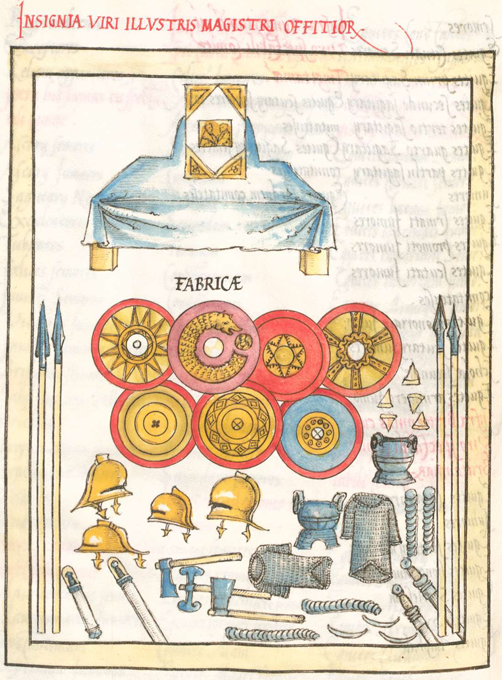
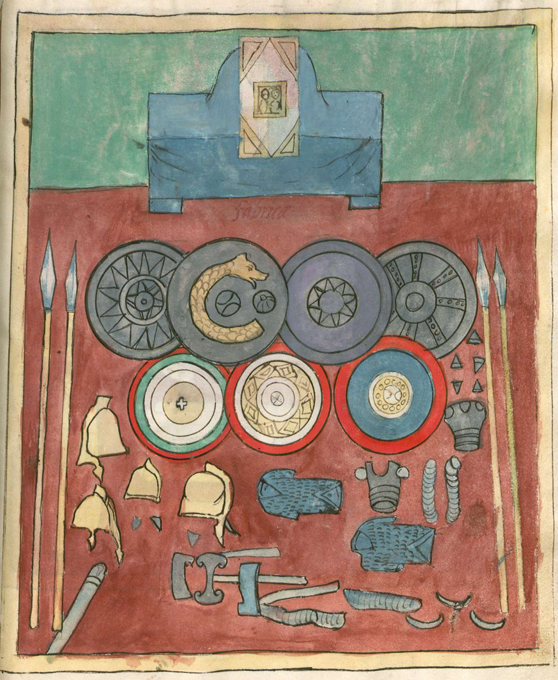
The picture from M suffers from some colour problems: the presumably purple-grounded shield second-in from the top left, and which is more indigo in O and pale-blue/lilac in B, is in M faded to a pale maroon. Further, all the greens have faded to yellow. However, the colours are even worse in W, in which the top row of shields appears to have essentially been not coloured in at all by the inker.
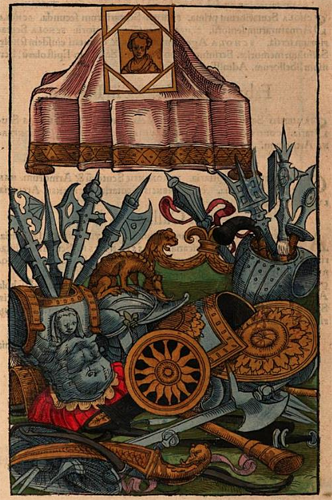
|
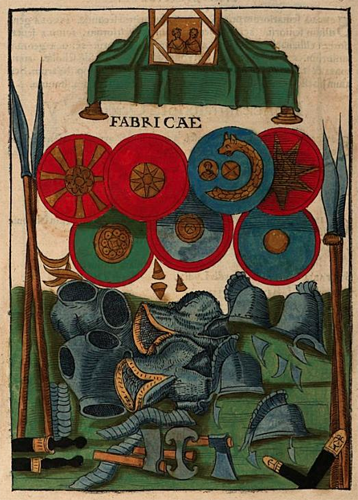
|
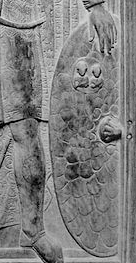
Detail from the Stilicho diptych. Public domain image originally from Pierce & Tyler, L'art byzantin, Paris, 1932 |
Above left is the corresponding illustration printed Froben edition (B). It can be seen that in this particular case (and only in this case) the image is wildly divergent from those of the other manuscripts. To further complicate things, in the Froben edition, the images for the eastern and western Masters of Offices appear to have been swapped, so the image shown above centre, and which purports to be from the eastern Magister Officiorum, actually shows the western shields. Interestingly, the shield lying down with the pattern of overlapping leaves in the "western" picture is somewhat reminiscent of that of the shield of Stilicho on the famous diptych showing him and his family, as shown above right.
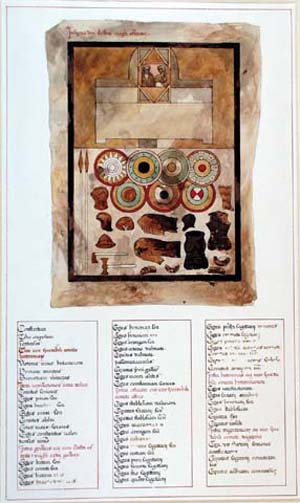 Image copyright claimed by the museum. See here for what I make of that... |
Illustrated to the left is a watercolour now residing in the Castle Museum and Art Gallery at Norwich. This was painted in the mid-19th century by the English pre-Raphaelite artist Frederick Sandys, and is a copy of a page from the now fragmentary Cambridge manuscript (C). Only five folia (i.e. ten pages: 1r, 1v, 2r, 2v, 3r, 3v, 4r, 4v, 5r, 5v) are now known to exist from C; that copied by Sandys is not one of them. The original pictures from which this and Sandy's other watercolours were copied were apparently framed and in the 19th century displayed in some cottages in Norfolk, having been dismembered from C at some point. It is to be hoped that one day these now-lost pictures may be found: see here for an extended discussion by Ingo Maier.
Comparing Sandy's copy of C with those of O, P, M, and W, although the broad picture is the same, there are clear differences in the details of the pictures - different numbers of the ancillary weapons, etc. Looking at the shields in particular, you can see that while their number and placement are the same, the patterns look rather different. Certainly the colours are not the same. Although this may have had something to do with the painting being a watercolour, a comparison of this and two other of Sandy's pictures with the colour palette of the remaining five original folia of C shows that they would appear to be identical, meaning Sandy's colours are faithful to C. The question then arises which is more faithful to the copy of the original (and now lost) archetype from which all the extant Notitia versions derive, the Codex Spirensis: Sandy's copy of C, or instead one or more of O, P, M, and W. As discussed here, W is likely more true to the Codex Spirensis copy in broad strokes than O, P, and M, if not in small details, and definitely not in colours. Whether C is more faithful than W in broad strokes is debatable, but it is likely to be more faithful than O, P, and M, at least in terms of the presence of anachronistic embellishments; whether it is more faithful than O in terms of fidelity of detail is to be doubted, however. Some shields in Sandy's copy are more clearly similar to the corresponding shields in the other manuscripts than are others. For example, 106#4 (the first shield from the top left) has an identical design, and with respect to the colouring, it at least has the same red rim as in O, P, and M. The next shield, 106#5, is completely different, however, and while the third shield from the left, 106#6, is of similar design, it has very different colours. |

Return to the Notitia index page.